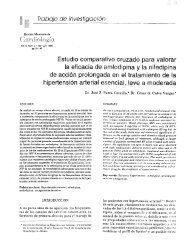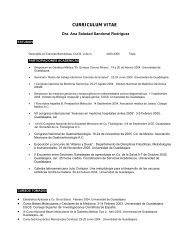Desigualdad Social y Equidad en Salud: Perspectivas Internacionales
Desigualdad Social y Equidad en Salud: Perspectivas Internacionales
Desigualdad Social y Equidad en Salud: Perspectivas Internacionales
- No tags were found...
Create successful ePaper yourself
Turn your PDF publications into a flip-book with our unique Google optimized e-Paper software.
able, and also unjust (Whitehead 1992). Whitehead prompts a number of questionsregarding equity. For example, what are the differ<strong>en</strong>ces that are unnecessary andavoidable? The studies done by Whitehead id<strong>en</strong>tify four categories in which the differ<strong>en</strong>cesin health are unnecessary, avoidable and unjust:• Differ<strong>en</strong>ces due to life styles that harm the health of an individual or a socialgroup, where the choices of the individual or the group are restricted.• Exposure to work <strong>en</strong>vironm<strong>en</strong>t that are unhealthy and stressful.• Inadequate access to services, which are ess<strong>en</strong>tial to health, including otherpublic services.• The t<strong>en</strong>d<strong>en</strong>cy that people who live in the poorest social strata suffer moreillness.There is also a differ<strong>en</strong>ce that must be made betwe<strong>en</strong> a population’s equity to healthand equity in the delivery of health services. The World Health Organization definesequity in health as the notion by which each individual and group must <strong>en</strong>joy thehighest level of physical, psychological and social well being that is permitted by biologicallimitations. On the other hand, equity in the delivery of services means thatresources and services of the health sector are distributed and provided according tothe needs of the population, and the services are financed according to the capacityof the population to pay.In a more operational manner, it can be said that wh<strong>en</strong> we talk about equity inrelation to health status of a population we are talking about levels of mortality andmorbidity experi<strong>en</strong>ced by the social groups of said population. Equity on healthservices delivery refers to levels of access, utilization and financing of health servicesthat are experi<strong>en</strong>ced by the differ<strong>en</strong>t social groups.The differ<strong>en</strong>tiation of equity in health and equity of delivery of services is significantfor the definition of health policies and programs that promote health. Due toanalytical purposes, the results from the theoretical revision have be<strong>en</strong> organizedaccording to equity of resource allocation and equity of access to health services.Process of Dec<strong>en</strong>tralization and its Impacton Some of the Countries in the RegionAlthough dec<strong>en</strong>tralization can be defined as the transfer<strong>en</strong>ce of power and compet<strong>en</strong>cesfrom the c<strong>en</strong>tral governm<strong>en</strong>t to peripheral levels of governm<strong>en</strong>t, this means,changing the place where the decisions are tak<strong>en</strong> and putting them under the controlof the community (Guimarâes 2001); this implies a great variety of processes in thediffer<strong>en</strong>t countries of the region. First, differ<strong>en</strong>t geographic levels can be involved.This includes not only provincial or municipal authorities, but also, on occasion,dec<strong>en</strong>tralized institutions or areas as well. In addition, the transfer can imply diverse12 Dec<strong>en</strong>tralization And Equity
















